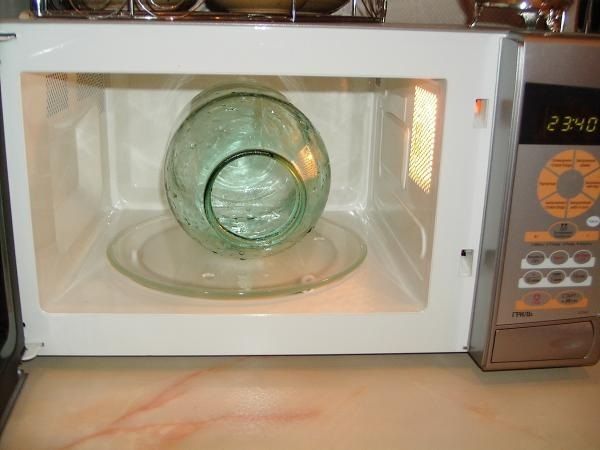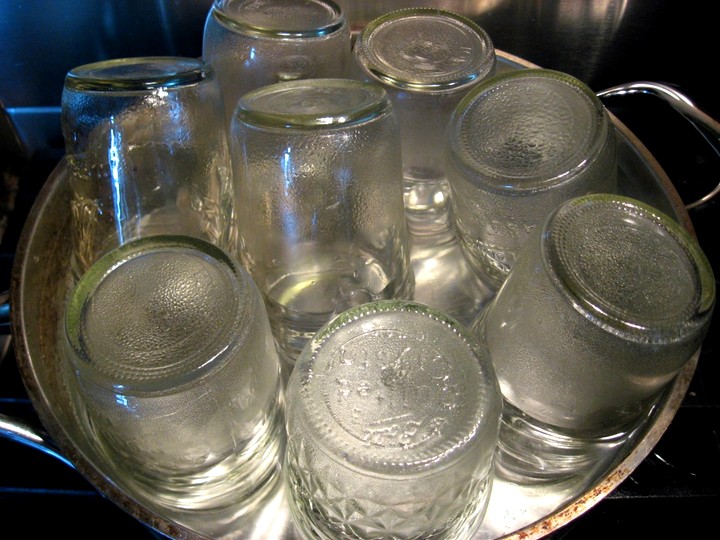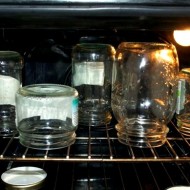Sterilizing cans for preservation in the microwave - 2 easy ways
Content
Pros and cons of microwave sterilization
Sterilization is a stage without which no preservation can do. It is necessary for the destruction of pathogenic microorganisms on the walls of glass containers. If the workpiece is placed in an unprepared jar, the product will quickly deteriorate and become unusable.

The advantages of microwave sterilization are simplicity and speed
With the development of modern technology, housewives are increasingly using microwave ovens for disinfection.
- Fast processing. Microwave sterilization time is only a few minutes.
- Effective destruction of germs. In addition to hot steam, bacteria are exposed to microwave waves.
- Maintaining normal humidity and temperature levels. Unlike a steam bath, a microwave does not spoil the microclimate.
- Preservation of cans. Proper handling reduces the risk of damage to glass containers.
- Small capacity. Containers with a volume of more than 4 liters must not be sterilized. Large cans (3 l) must be handled separately on their side.
- Energy consumption. When using a microwave oven, electricity consumption is significantly increased.
- Inability to sterilize the lids. Do not ignite metal objects in the microwave.
Video "Sterilization of cans: 3 ways"
This video shows you how to sterilize glass containers in the microwave, oven, and steam.
Preparing cans
In order for the conservation to stand all winter and not deteriorate, it is necessary to approach the preparation of glass containers very seriously. There should be no cracks or chips on the cans. Otherwise, they may burst during sterilization. You need to carefully inspect them and, if there is the slightest damage, replace them with whole ones.
Selected containers must be washed well. It is better to use laundry soap or baking soda, as detergents do not wash out well. The procedure is carried out with an iron brush, under the powerful pressure of running water. Be sure to dry the jars before placing them in the microwave.
Caps should also be carefully inspected, rinsed and sterilized for 15 minutes.
- 1. Inspection
- 2. Washing
- 3. Drying
Steam treatment
The easiest and most frequently used method. It consists of the following steps:
- Liquid is poured into clean, dry jars so that it covers the bottom by 2-3 cm. The water must be filtered, otherwise scale will form on the walls.
- Place the container on the rotating plate of the microwave oven in such a way that nothing interferes with its movement. Three-liter jars are placed on their side, with a dry towel folded in several layers.
- For processing containers with a volume of up to 1 liter, set the power to 1000 W and sterilize for 4 minutes. Larger cans languish for 7 minutes at 650 watts. Make sure the water boils. To be on the safe side, it is recommended to sterilize the jars for 1-2 minutes longer than the prescribed time.
- The disinfected containers are removed with dry tacks, the liquid is drained and wiped dry with sterile gauze. Banks are placed on a dry towel upside down. They are kept in this position until the start of conservation.

Pre-containers are treated with steam
Dry sterilization
The principle of operation is that after processing the containers do not need to be additionally dried. To properly disinfect the container, you need to follow several rules:
- Only dry cans are processed. They are placed on a rotating plate in a circle, and a glass of water is placed in the middle. Do not add 3-4 cm to it so that the liquid does not splash when boiling.
- Set the power to 750 W and sterilize for 5 minutes.
- After the time has elapsed, the containers are removed with a dry towel and the blanks are laid out.
We sterilize cans with blanks
It's not just empty jars that can be sterilized. Sometimes the process is carried out together with blanks. Pasteurization is carried out at a temperature not exceeding 100 ° C. This helps the products retain more nutrients, but store such seams in a cool place. Before the procedure, all lids are removed from the containers.
If vinegar is present in the marinade, you do not need to process the container additionally.

Table: rules for sterilization of cans with blanks
With salty foods
The main rule for sterilizing jars of salty foods is that they must be ⅔ full. The remains of the workpiece are collected after processing. Otherwise, the boiling marinade will spill out and stain the microwave. The procedure is performed as follows:
- The filled containers are placed on a rotating plate, avoiding contact with the walls.
- They languish for 3 minutes at maximum power.
- Withstand conservation for another 5 minutes with the microwave oven turned off.
- The cans are removed with a dry tack and allowed to cool.
- The blank is added to the brim and then rolled up.

Can be sterilized both empty and filled with food
With raw berries and fruits
The method is well suited for harvesting fresh currants, gooseberries, raspberries, strawberries, lingonberries, cherries or sweet cherries for the winter. The sterilization procedure is very simple and involves several steps:
- Sugar syrup is prepared on the basis of purified water. The sweetness is selected individually.
- The washed fruits are carefully sorted out without removing the seeds. Spoiled or mashed berries and fruits are not suitable for preservation.
- The workpiece is scattered over the jars, leaving 5 cm from the neck.
- The syrup is poured so that it covers the fruits, and sterilized for 5 minutes at maximum power.
- Take the jars out of the microwave with a dry towel and add the remaining syrup.
With jam
You need to lay out the jam in the jars so that at least 5 cm remains to the edges. This will prevent the contents from spilling onto the rotating plate. The algorithm for processing filled containers is simple:
- The containers are placed in the microwave so that the glass walls do not come into contact with each other.
- The procedure is carried out at maximum power for 6 minutes.
- Withstand another 5 minutes with the door closed and the microwave oven turned off.
- They are removed using dry oven mitts, cooled and rolled up with a kitchen key.
Microwave sterilization is a fast and effective method for preserving cans. Observing all the rules, you do not have to worry about the safety of winter preparations. They will not explode, will not grow cloudy, and will reach the spring without any problems.



